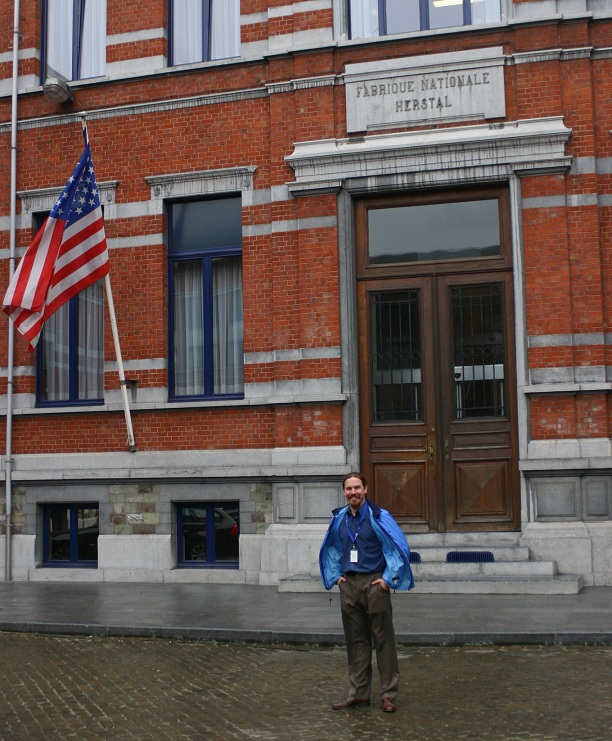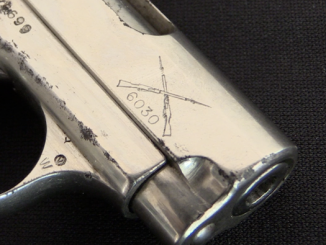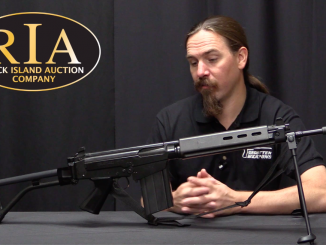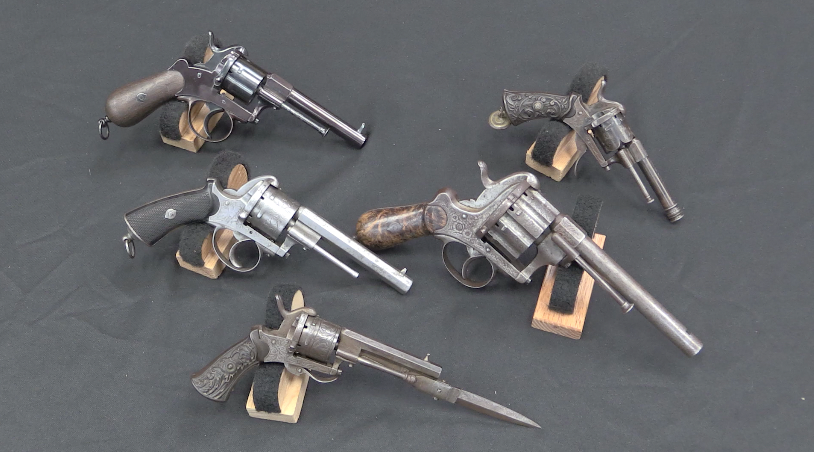Forgotten Weapons is currently in the midst of a 3-week European tour, and yesterday we were very fortunate to be able to tour the facility at FN Herstal. For folks who aren’t familiar with the company, FN worked extensively with John Browning for many years, producing many of his iconic designs. Browning had an office and workshop in Herstal, and his sudden (and untimely) death occurred at his workbench here. Today, the FN group includes not just Browning and FN, but also Winchester firearms and Winchester-Olin ammunition manufacture. For military clients, this allows FN to be a complete supplier, providing firearms, mounting systems, and ammunition.

Being located in eastern Belgium, the Herstal factory has been the unfortunate recipient of German attention in both World Wars. The factory was occupied in both cases, and most of the machine tools carried off ahead of the Allied liberation. In WWII, the factory was run with local forced civilian labor by the Nazis, and between that and its location in the city center of Herstal, Allied forces did not bomb the facility. After liberation, however, the plant was the target of V1 and V2 rocket attacks. Most of the buildings were destroyed, although two of the original buildings still stand. Most of the remainder were rebuilt in the late 1940s.
After the liberation, FN was able to get back on its financial feet by starting with the manufacture of jerry cans for gasoline, as they were needed and did not require much complicated tooling to produce. With this cash flow, it was possible to rebuild the plant and develop FN’s postwar designs, such as the SAFN (FN-49).
Our tour began in the former office of John M. Browning, which FN has maintained as a conference room. Browning is without a doubt the premier firearms designer in world history, and FN is very proud (and rightfully so) of its long association with Browning.
With the photo opportunities taken care of, we moved on the the technical tour, starting with the barrel shop. FN makes all its barrels from raw steel rod in-house. First a blank rod is center drilled, and then turned to a basic outside profile (about an inch in diameter, for most rifle barrels). A mandrel with thereverse impression of the rifling is run into the bore, and a rotary machine hammers the blank barrel down onto that mandrel, leaving the rifling pressed into the inside of the bore. Barrels can then be turned down to proper specification for each particular application. This is known as a cold-hammered technique, and it is how FN manufactures all its barrels (with the exception of one type of M2 .50 BMG barrel).
Our next step was one of the machining shops, where parts like receivers, bolts, trunnions, and other parts are manufactured. FN uses a variety of materials, from the tradition steel billet wiled to the desired shape (for FN MAG trunnions, for example) to aluminum billet milled down (the Minimi top cover, among others), steel forgings milled (like the M2 bottom plate), and even aluminum extrusions (like the SCAR receiver). This use of aluminum extrusion is particularly interesting, as it allows a very cost-effective production of fairly intricate features.
Extruding aluminum is basically the process of heating up a large block and squeezing it through a die like pasta. The die can produce small details like grooves and lips to very tight tolerances, as long as the cross-section of the material does not have to change. The extrusion can then be made in long sections (20 feet or more) and cut into the necessary lengths for making guns. In the case of the SCAR, all three variants (.223, .308, and .308 heavy barrel) are designed with the same receiver shape, just in different lengths. The extrusion contains the bolt rails, part of the picatinny rail, and other details, so those elements do not need to be machined. Instead, it is just a matter of cutting out the ejection port and adding holes to bolt in trunnions.
We are, by the way, quite impressed with the SCAR. It has all the features of a modern combat rifle, and quite well done. The receiver has an integral rail along its top surface, a free-floating barrel, simple disassembly, and easily changeable barrels. It also comes from FN with many of the elements that generally need to be purchased aftermarket on ARs, like the rails, high quality folding adjustable-length stock, etc.
But back to the tour – we next moved into the assembly building, where the various parts are assembled into complete guns. FN’s military firearms (and the civilian versions of them, like the FS2000 and P90S) are all assembled here in Belgium, while the sporting guns are assembled elsewhere. Each gun is tested for headspace, and assembled with care by individual workers – this is not an automated procedure. In the case of a SCAR, the complete assembly is about a 70-minute process for each gun.
Once assembly is finished, every weapon is test fired, for accuracy, reliability, and cyclic rate (in the case of machine guns). We chatted with one of the test firers (fun job, eh?) who was working with a batch of FN MAG light machine guns. He used a 50-meter test range with a camera system showing him his target, and an optical chronograph to measure cyclic rate and bullet velocity. In the case of the MAG, he also tested firing a short belt with a weight hung off the end, to ensure that the weapon would function with a long belt hanging out, or other pull on the system. For military customers, FN has guarantees of accuracy and specified cyclic rate, and they can also provide spare barrels matched to individual weapons like the MAG.
We had the lucky privilege of being able to view the reserve collection that FN keeps, which has some amazing pieces. In addition to examples of pretty much all the common firearms systems form the past hundred years, the collection includes many FN prototypes, including SCARs, FALs, MAGs, and some interesting one-off projects like an M2 scaled up for a 15mm cartridge, and belt-fed sample of an FN-D. The first prototypes of the MAG light machine gun, for example, were designed to use either belt or magazine feed (much like the Minimi).
Our final stop was the formal showroom, typically used for major clients. It was recently built, and is a great example of how a firearms showroom should be made. The foyer has display cases of some of FN’s particularly prominent historical products (the Mauser rifle, model D BAR light machine gun, Browning 1910/22 pistol, and FAL rifle). Then the main area has displays of every model currently in production by the factory (SCAR, Minimi, MAG, FNP pistols, less-lethal systems, M2, door mounting systems, remote operated gun emplacements, P90, FS2000, etc). These guns all have pinned barrels, and can be handled, disassembled, and generally fondled to your heart’s content. We had a great time stripping down a SCAR-L, and I think I probably need to get myself an FNP-45.
Did you know that FN is now producing the Minimi in .308 caliber? It was originally designed in both .223 and .308, but at the time (30 years ago) the .308 was not particularly desired by the market, so it was sidelined. Today there is a lot of interest in that gun, as it is barely heavier that the .223 Minimi, and much more practical as a heavy-caliber SAW that something like the MAG (which is more of a mounted or implaced weapon).
I have barely scratched the surface of what we saw and learned, but I have rambled long enough for one day. We are thrilled to have been able to visit the facility at Herstal (is you hadn’t been able to tell) and see the production floor – this is a place with a massive amount of history, and continues to be one of the premier firearms manufacturers in the world. A hearty thank-you goes out to the folks who helped us arrange the invitation (you know who you are), and to Kristof for the excellent tour and the patience with our myriad questions!




From the stand point of this trip so far. This was by far the most insightful part of the trip. The small amount that I was able to learn in just a short tour was impressive. I have been interested in small arms for the last 50 years and seriously working on them for the last 30 years. The opportunity to see early FAL prototypes was exciting and fascinating. The knowledge that I have gained on this trip will greatly improve my understand of small armes design and manufacturing.
Thanks for the very informative article about FN Herstal, Ian! As usual, it was both comprehensive and well-written.
Two small points I’d like to bring up :
1. I think the scaled-up version of the M2 in 15mm calibre you are referring to may be the FN-BRG heavy machine gun that was originally designed in the 1980’s as NATO’s answer to the Soviet 14.5mm KPV HMG. After initial testing, FN found that the ballistic characteristics of the 15mm cartridge caused excessive barrel wear, so they re-designed the weapon around a slightly larger 15.5mm cartridge that not only satisfactorily resolved the issue but which also had superior ballistic performance and terminal effects on the target. Unfortunately, FN was bought out by another firm at the time, and the BRG was shelved. When FN regained their status as an independent company some years later, the market for the BRG had changed and my understanding is that the design is currently in mothballs awaiting a more propituous time for re-introduction.
2. Isn’t the MAG58 classified as a GPMG rather than an actual true LMG? It’s size ( 48.5″ overall ) and weight ( 24.5 lbs. empty ) and ability to function as an LMG ( on its integral bipod ) or sustained-fire MMG ( on a tripod ) would definitely qualify it as the former.
Thanks once again for sharing your visit with the rest of us. Will you be visiting the CZ or CSA ( D-Technik ) factories in the Czech Republic during this tour?
Thanks, Earl.
What we were told with the 15mm is that it was found that a projectile over .50 caliber really required driving bands, to avoid excessive barrel wear as you mention (and high chamber pressure, I imagine). Our tour guide said that the drive bands simply made the ammo uneconomical for the intended role, and the idea was dropped.
The MAG58 is more accurately a GPMG, you’re right.
On this trip, we have time in France, Belgium, and England. We have definite plans to visit the Czech Republic (as well as Finland and Switzerland, and Israel if possible) over the next few years. So many places to go, and so little time (and money)!
When did FN buy the Winchester-Olin ammunition business? I thought that Olin held that back when they sold off Winchester.
Yes, I remember reading about the use of driving bands on the 15.5mm rounds used in the later version of the BRG to reduce the contact area inside the barrel bore and therefore significantly reduce barrel wear. In the original 15mm version, the extensive direct surface contact area between such a large projectile and the bore was cited as being almost entirely responsible for the excessive barrel wear previously mentioned.
I hadn’t realized that Mg-42 was traveling on the same tour. From what I’ve read of his previous comments, he certainly seems to be a storehouse of knowledge and experience that can only enhance this site.
I am definitely looking forward to reading the next several posts as you continue with your journey.
Take care, be safe and Godspeed.
“…I think I probably need to get myself an FNP-45.”
I’ve got one and I’d love to love it, but there are a few niggling complaints.
1) It appears to be very finicky about cartridge Overall Length. If the rounds are shorter than it likes it hangs up repeatedly. FN tests the guns with 230gr Speer Gold Dots and those run great, but Hornady XTP’s and even 230gr ball are hit-or-miss unless they are the perfect OAL.
2) The retention method for their replaceable backstaps is pretty crappy. I would up using RTV to glue mine into place because the little plastic catch wouldn’t hold the grip in place.
3) I like to detail strip any gun I own. I’m not sure if it’s actually possible to break an FNP-45 down to the bare frame. If it is possible I’d love to get a link to the procedure.
Ian, I must know!
Once they cold hammer the barrel onto the rifling mandril, how do they get the mandril out of the barrel? Do they just pull it out somehow?
Yes, the mandrel just twists back out of the barrel. The functional portion is only about 3 inches long – as they hammer the barrel around it, the mandrel is pushed continuously pushed through.
FN was founded to manufacture Mauser M1889 rifles for Belgium. There were disputes about manufacturing rights and Ludwig Loewe (owner of Mauser) decided to buy the company. So FN was owned by the Germans up to the end of WWI.
This is no excuse for the German war against Belgium. But speaking of German occupation of a company they owned is somewhat distorting the facts.
The SCAR-L wasn’t binned by SOF (technically, production stopped) because of dissatisfaction with the gun, but because it didn’t offer enough capability boost over the M4A1 SOPMOD to justify expending MFP-11 dollars. M4s come from regular Title 10 dollars for Big Green, special ops peculiar weapons come from MFP-11 along with all other SOF arms and equipment. SCAR-H endures.
For someone buying his own semi-auto, the civilian one is a good M4 alternative. The civilian versions are built in Belgium and then rebuilt in the USA for 922 compliance. Not their fault, look at Congress (in Congress, in Congress, we make our laws incongruous).
The .308 Minimi is fielded in the US forces as the Mk48. As far as I can tell it is just the Mk46 (SOF variant of the 249) scaled up. It was developed for SOCOM and has been in full rate production for almost 10 years! Like most (all?) FN weapons for US forces, it’s made at FN’s plant in the USA (Columbia, SC).
There’s also a titanium-receiver MAG. It gives up some durability to ease the gunner’s load.
SOF weapons have Naval designations (Mk X Mod Y) because Joint SOF weapons are developed by the Naval surface waftare lab in Crane, Indiana. They do it with a ton of joint input, of course.
Greetings,
I enjoyed your Forgotten Weapons story about Herstal. I found your site seeking information about the forced labor force at the plant during WWII. My mother was one of the coursed labor workers there during the war. She lived in Liege about 3 miles from the plant and was approximately 14-15 years old when examined by a Gestapo doctor and ordered to work. She shared several stories of working there like the day word arrived at the plant that the Allies had landed at Normandy. She said the plant commander jumped in a half track and ran through a brick wall trying to leave the plant fearing the labor force turning into a mob. I still have relatives in Liege and throughout Belgium. If interested, I’d love to share a bit more of her WWII stories.
Thanks, David P. Cummings
Hi David – I would very much like to hear your mother’s stories about Liege during the war! Can you email me at ian@forgottenweapons.com?
Hi David,
I believe that I am in possession of a late war Sauer 38 H pistol that was surrendered to an OSS interagating officer by the factory commander. I would love to hear about anything connected with that. Thanks, Warren
muckamoo56@gmail.com
I am traveling to Brussels soon. I am wondering how you were able to set up the tour. Also, what other things would you suggest to visit?
FN doesn’t do public tours – I was able to arrange one because of this web site and some personal connections – sorry! If you’re in Brussels, though, you should definitely visit Cornet & Company – they are an excellent gun shop with a very friendly staff. The Royal Museum of the Armed Forces and Military History is also well worth a visit.
Hallo;
My name is Hugo Jensen. I have got a fine old FN (Browning Patents) superposed shotgun. It is a FN B 25 procuces in 1972, gauge 12 (S 72) with the serial number 10308 S72.
It is engraved by Lilly Lambert. The strange thing is, that the gun has B2G engravements (pheasants on the left side and ducks on the right), but it has the notification B2 and not B2G. On the gun it says 10308 S72 B2 (not B2G????). Why????
Can anyone answer the question why that is so?
Kind Regards
Hugo Jensen
Denmark
I am belgian and proud of our past history.
Being a descendant of the famous Jean Curtius, , I would love to visit, with some American visitors this July , the FN in Herstal or even a local gun manufacturer. Is it something possible ?
Best regards,
Ludovic de Potesta
Unfortunately, you’ll have to talk to FN about setting up a visit.
I was the project officer for the purchase and fielding of the M240 (MAG 58) coaxial machine gun for our main battle tanks. It was the first in a family of weapons that have been mounted on many of our combat vehicles. I visited the plant in Herstal many times and had the pleasure of shooting pistol and skeet against the plant manager(for drinks, which he later bought). I was impressed with the dedication of everybody on the line and their commitment to quality. When FN opened their SC plant two of the team became FN employees.
R. F. Landin, LTC(R) USA
Tem algumas armas experimentais da FN que vi fotos e gostaria de conhecer melhor, mas não consigo achar na internet. Não sei como fazer contato com vocês para mandar as fotos.
For approximately 60 years I own an FN rifle Caliber 0.22 serials Number 113939.
Here we call it a pump gun I would like to know the year of manufacture end other informasion on this rifle. Can you help me
Thank you in advance
Yehuda Yakubovitz